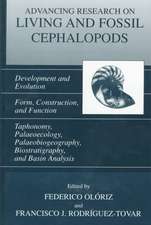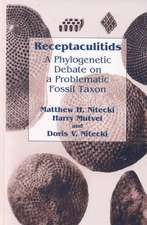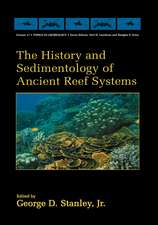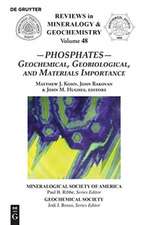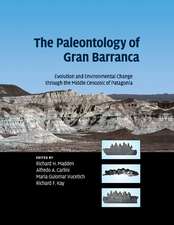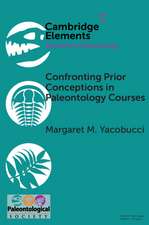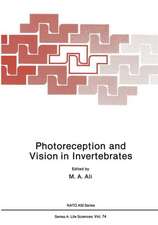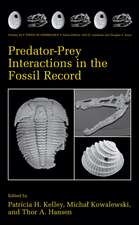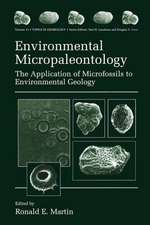Paleobiogeography: Topics in Geobiology, cartea 16
Autor Bruce S. Liebermanen Limba Engleză Paperback – 30 sep 2012
Paleobiogeography emphasizes how analytical techniques from phylogenetic biogeography can be applied to the study of patterns in the fossil record. In doing this, it considers the strengths and weaknesses of paleobiogeographic data, the effects of plate tectonic processes (specifically continental rifting and collision) and changes in relative sea levels in terms of how they influence the evolution and distribution of organisms.
| Toate formatele și edițiile | Preț | Express |
|---|---|---|
| Paperback (1) | 633.31 lei 6-8 săpt. | |
| Springer Us – 30 sep 2012 | 633.31 lei 6-8 săpt. | |
| Hardback (1) | 648.74 lei 6-8 săpt. | |
| Springer Us – 31 mai 2000 | 648.74 lei 6-8 săpt. |
Din seria Topics in Geobiology
- 18%
 Preț: 1858.10 lei
Preț: 1858.10 lei - 20%
 Preț: 822.08 lei
Preț: 822.08 lei - 15%
 Preț: 672.43 lei
Preț: 672.43 lei - 18%
 Preț: 1236.82 lei
Preț: 1236.82 lei - 15%
 Preț: 647.59 lei
Preț: 647.59 lei - 24%
 Preț: 885.02 lei
Preț: 885.02 lei - 18%
 Preț: 951.59 lei
Preț: 951.59 lei - 18%
 Preț: 964.23 lei
Preț: 964.23 lei - 18%
 Preț: 1117.69 lei
Preț: 1117.69 lei - 18%
 Preț: 966.27 lei
Preț: 966.27 lei - 18%
 Preț: 952.54 lei
Preț: 952.54 lei - 18%
 Preț: 949.85 lei
Preț: 949.85 lei - 18%
 Preț: 1013.50 lei
Preț: 1013.50 lei - 24%
 Preț: 821.17 lei
Preț: 821.17 lei - 18%
 Preț: 952.40 lei
Preț: 952.40 lei - 18%
 Preț: 961.23 lei
Preț: 961.23 lei - 18%
 Preț: 952.26 lei
Preț: 952.26 lei - 18%
 Preț: 960.42 lei
Preț: 960.42 lei - 18%
 Preț: 1843.11 lei
Preț: 1843.11 lei - 18%
 Preț: 954.31 lei
Preț: 954.31 lei - 18%
 Preț: 1256.41 lei
Preț: 1256.41 lei - 18%
 Preț: 959.50 lei
Preț: 959.50 lei - 15%
 Preț: 673.60 lei
Preț: 673.60 lei - 18%
 Preț: 954.14 lei
Preț: 954.14 lei - 15%
 Preț: 640.06 lei
Preț: 640.06 lei - 18%
 Preț: 959.36 lei
Preț: 959.36 lei
Preț: 633.31 lei
Preț vechi: 745.07 lei
-15% Nou
Puncte Express: 950
Preț estimativ în valută:
121.18€ • 126.86$ • 100.27£
121.18€ • 126.86$ • 100.27£
Carte tipărită la comandă
Livrare economică 05-19 aprilie
Preluare comenzi: 021 569.72.76
Specificații
ISBN-13: 9781461368670
ISBN-10: 1461368677
Pagini: 232
Ilustrații: XIX, 208 p.
Dimensiuni: 178 x 254 x 12 mm
Greutate: 0.38 kg
Ediția:Softcover reprint of the original 1st ed. 2000
Editura: Springer Us
Colecția Springer
Seria Topics in Geobiology
Locul publicării:New York, NY, United States
ISBN-10: 1461368677
Pagini: 232
Ilustrații: XIX, 208 p.
Dimensiuni: 178 x 254 x 12 mm
Greutate: 0.38 kg
Ediția:Softcover reprint of the original 1st ed. 2000
Editura: Springer Us
Colecția Springer
Seria Topics in Geobiology
Locul publicării:New York, NY, United States
Public țintă
ResearchCuprins
1. What Is Paleobiogeography?.- 2. The Relevance of Hierarchy Theory to Biogeography and Paleobiogeography.- 2.1. Introduction.- 2.2. The Genealogical and Economic Hierarchies.- 2.3. Hierarchies and Evolution.- 2.4. Hierarchies and Biogeography.- 2.5. Climate Change and Biogeographic Patterns.- 2.6. Geological Change and Biogeographic Patterns over Even Longer Timescales.- 2.7. Mass Extinctions and Biogeography.- 2.8. Conclusions.- 3. On the Quality of the Fossil Record and What a Paleobiogeographer Can See.- 3.1. Introduction.- 3.2. Taphonomic Studies.- 3.3. Area and Volume of Sediments.- 3.4. Phylogenetic Studies.- 3.5. Confidence Intervals on Stratigraphic Ranges.- 3.6. Studies of Sedimentation Rates and Stratigraphic Completeness.- 3.7. Conclusions.- 4. The History of Biogeography and Paleobiogeography.- 4.1. Introduction.- 4.2. Preevolutionary Biogeographic Views.- 4.3. Evolutionary Biogeography.- 4.4. The Role of Isolation as a Mechanism of Speciation and Biogeographic Differentiation.- 4.5. Conclusions.- 5. Allopatric Speciation and Vicariance.- 5.1. Introduction.- 5.2. The Relevance of Allopatric Speciation to Historical Biogeography.- 5.3. Comparing Sympatric and Allopatric Speciation.- 5.4. Why Speciation Is Important in Biogeography?.- 5.5. Why Speciation Is Especially Important in Paleobiogeography?.- 5.6. The Relationship among Allopatric Speciation, Punctuated Equilibrium, and Dispersal.- 5.7. Conclusions.- 6. Vicariance, Dispersal, and Plate Tectonics.- 6.1. Introduction.- 6.2. Dispersion and Dispersal.- 6.3. Traditional Dispersal.- 6.4. Defining a Different Type of Dispersal: Geodispersal.- 6.5. Historical Framework on the Concept of Geodispersal.- 6.6. Integrating Vicariance and Geodispersal with Plate Tectonics.- 6.7. Relating Earth History and Evolution: General Perspective.- 6.8. Limits of Resolution in the Fossil Record, Our Ability to Identify Paleobiogeographic Patterns, and Conclusions.- 7. Defining Areas in Paleobiogeography.- 7.1. Introduction.- 7.2. Species Concepts: Ontology and Epistemology.- 7.3. The Individuality of Species.- 7.4. Translating the Debate about Species to the Debate about the Nature or Ontology of Areas.- 7.5. The Epistemology of Areas.- 7.6. Conclusions.- 8. Biogeography and the Comparative Method.- 8.1. Introduction.- 8.2. Phylogenetics and Biogeography.- 8.3. Tracing Biogeographic Distributions Group by Group: the Problem of Ancestors.- 8.4. Quantitative Approaches to Reconstruct the Historical Biogeography of Individual Clades.- 8.5. Areas as Binary Characters.- 8.6. Dispersal-Vicariance Analysis.- 8.7. Conclusions.- 9. The Search for Congruence: Analyzing Biogeographic Patterns in Several Clades.- 9.1. Introduction.- 9.2. Potential Sources of Noise in Paleobiogeographic Studies.- 9.3. Extinct Taxa and the Difference between Biogeography and Paleobiogeography.- 9.4. Additional Basic Assumptions of any Biogeographic Study.- 9.5. Analytical Approaches to Historical Biogeography.- 9.6. Phenetic Approaches to Biogeographic Analysis.- 9.7. Probabilistic Approaches to Biogeographic Analysis.- 9.8. Analytical Approaches to Biogeography within a Phylogenetic Framework.- 9.9. Arguments about Using Parsimony Algorithms in Biogeography.- 9.10. Other Criticisms of Brooks Parsimony Analysis that Are No Longer Valid.- 9.11. Parsimony Analysis of Endemicity.- 9.12. Case Studies Assessing the Efficacy of Components Analysis vs Brooks Parsimony Analysis that Used the Extant Biota.- 9.13. Paleobiogeographic Studies Using Phylogenetic Approaches and the Modified Version of Brooks Parsimony Analysis.- 9.14. Further Issues in Cladistic Biogeography that Need to be Explored.- 9.15. Conclusions.- 10. Biogeography and the Biodiversity Crisis.- 10.1. Introduction.- 10.2. Invasive Species and the Biodiversity Crisis: Geodispersal and Merging Areas of Endemism.- 10.3. Analogues from the Past: the Late Devonian Mass Extinction.- 10.4. Habitat Destruction and the Biodiversity Crisis: Destroying Areas of Endemism.- 10.5. Historical Perspective on Biogeography’s Role in Understanding the, Biodiversity Crisis.- 10.6. Biogeography: More Lessons from the Recent Past.- 10.7. Conclusions.- 11 Conclusions.- References.
Recenzii
Advance praise for Paleobiogeography:
`A wonderfully comprehensive and imaginative synthesis of the history of the earth and its living systems, Lieberman's Paleobiogeography blends hierarchy theory, ecology, plate tectonics, evolutionary theory and much more into a highly original mix of theory and interpretation reaching from the Paleozoic right up through the present-day Biodiversity Crisis. Everyone interested in the intricate dance between the physical and biological worlds must read this book - a genuine tour de force!'
Niles Eldredge, Dept. of Invertebrate Paleontology, The American Museum of Natural History, New York
`Bruce Lieberman's book is an important attempt to synthesize the fields of biogeography and paleobiology, which have been strangely isolated from each other for too long, to the detriment of both. Lieberman presents not only a coherent theoretical synthesis; he proposes specific practical techniques for research that may do much to tie geography to macroevolution. His methods and conclusions deserve widespread attention and discussion.'
Warren D. Allmon, Director, Paleontological Research Institution, Ithaca, NY
`Lieberman's book thus promises to initiate a new synthesis in the life sciences.'
American Scientist, 89
`Recommended for paleontological collections. Upper-division undergraduates through faculty.'
Choice, 38:8 (2001)
`Paleobiogeography is a thought-provoking book, and I hope it encourages others to explore its ideas further.'
The Quarterly Review of Biology, 76:3(2001)
`A wonderfully comprehensive and imaginative synthesis of the history of the earth and its living systems, Lieberman's Paleobiogeography blends hierarchy theory, ecology, plate tectonics, evolutionary theory and much more into a highly original mix of theory and interpretation reaching from the Paleozoic right up through the present-day Biodiversity Crisis. Everyone interested in the intricate dance between the physical and biological worlds must read this book - a genuine tour de force!'
Niles Eldredge, Dept. of Invertebrate Paleontology, The American Museum of Natural History, New York
`Bruce Lieberman's book is an important attempt to synthesize the fields of biogeography and paleobiology, which have been strangely isolated from each other for too long, to the detriment of both. Lieberman presents not only a coherent theoretical synthesis; he proposes specific practical techniques for research that may do much to tie geography to macroevolution. His methods and conclusions deserve widespread attention and discussion.'
Warren D. Allmon, Director, Paleontological Research Institution, Ithaca, NY
`Lieberman's book thus promises to initiate a new synthesis in the life sciences.'
American Scientist, 89
`Recommended for paleontological collections. Upper-division undergraduates through faculty.'
Choice, 38:8 (2001)
`Paleobiogeography is a thought-provoking book, and I hope it encourages others to explore its ideas further.'
The Quarterly Review of Biology, 76:3(2001)

